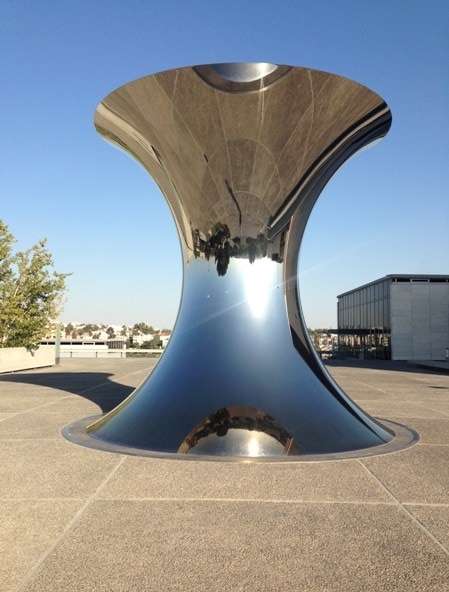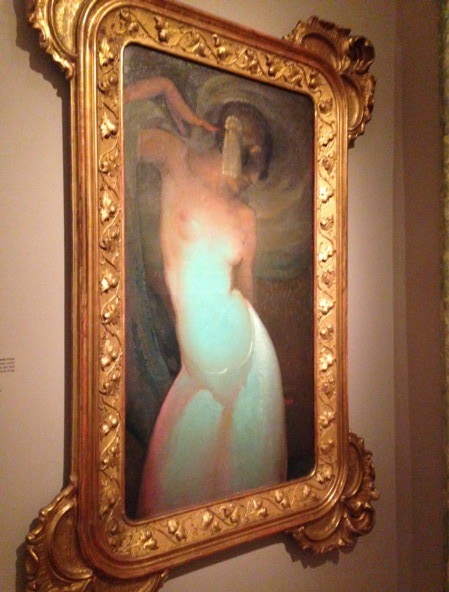
‘Turning the World Upside Down’ by Anish Kapoor, 2010
Any trip to a famous city would not be complete without a Sunday afternoon browse around a museum, especially if it houses particular treasures. Of course all art is subjective, but there are some things you really have to see and others that just catch your eye and imagination.
 The Israeli Museum sits below the watchful eye of the Knesset, the Israeli Parliament and the site is spread over some 12 acres, so with limited time it was important to choose which exhibitions to visit.
The Israeli Museum sits below the watchful eye of the Knesset, the Israeli Parliament and the site is spread over some 12 acres, so with limited time it was important to choose which exhibitions to visit.
But there was definitely one that I was not going to miss the chance of seeing – The Shrine of the Book

The Shrine of the Book contains the Dead Sea Scrolls discovered at Qumran in 1947
The white domed building was originally built in 1967 to house the first seven scrolls discovered at Qumran in 1947. It shapes represents the shape of the lids of the jars in which they were found, and is constantly sprayed with water from the fountain to keep the dome and the rooms beneath it cool.
Inside the cave-like building, in dimmed light are examples of the texts dating from the third century BC to the first century AD, most of which are written in Hebrew, a few in Aramaic and Greek. Most of the texts were written on parchment and only survived as fragments, but despite this scholars have been able to reconstruct about 950 different manuscripts. One manuscript, the Isaiah Scroll (Manuscript A) written around 100BC is the only biblical scroll from Qumran that has been preserved in its entirety – 734cm long, and a facsimile is displayed around the centre. Toward the end of the First Temple period, the Jewish people began to shape their ancient traditions into holy scriptures and thus became known as ‘the People of the Book’.
For out of Zion shall go forth instruction,
and the word of the Lord from Jerusalem.
Isaiah 2:3
Outside is a model of Jerusalem recreating the city of 66AD, at the time of the Second Temple at the height of its glory, on the eve of the great revolt of the Jews against the Romans.
From antiquity to modern art, I made my way through some of the outdoor sculptures

‘The strange loop you are’ by Mike and Doug Stern 2015
Created from bamboo poles and multi-coloured climbers ropes, in the Billy Rose Garden
 However, I think my favourite piece is the sculpture that heads this blog. The piece was commissioned in memory of Theodor ‘Teddy’ Kollek, the founder and father of the Israeli Museum and Mayor of Jerusalem for 28 years, a tribute to his vision for the museum. Under his tenure as mayor, Jerusalem developed into a modern city, and he was once called ‘the greatest builder of Jerusalem since Herod’
However, I think my favourite piece is the sculpture that heads this blog. The piece was commissioned in memory of Theodor ‘Teddy’ Kollek, the founder and father of the Israeli Museum and Mayor of Jerusalem for 28 years, a tribute to his vision for the museum. Under his tenure as mayor, Jerusalem developed into a modern city, and he was once called ‘the greatest builder of Jerusalem since Herod’
Made out of stainless steel there is a warning not to touch the piece, indeed the heat could be felt just by standing near to it.
Inside the Fine Arts exhibition there was one picture that really caught my eye, not necessarily because of its content, but the amazing green sheen that the artist had created for the dancer’s dress.

‘Salome’ by Egardo Sambo, 1920
Another favourite section was the Chinese contemporary artist Ai Weiwei’s ‘Maybe, Maybe Not’ exhibition. Weiwei was imprisoned without trial in his native China, and his movements were restricted by the government due to his political activism and outspoken stance on human rights and freedom of expression. Bearing this in mind, his decision to hold this exhibition in Israel caught many of his supporters by surprise. However, at its opening in June he told the crowds:
My voice should be heard. … I have to make the argument [and not say],
‘OK, let’s boycott it’ and ‘It’s nothing to do with me.’ I think that’s too easy.
I had already spotted one of his pieces outside, ‘Iron Tree’ which is a cast iron copy of the ‘Tree’ sculptures that are assembled from the dry, dead branches, roots and trunks of numerous species of tree, such as camphor, cedar and ginkgo, that Ai Weiwei gathered from across mountainous southern China. The sculpture mimics the form of a real tree, although the cuts and joins are left visible
Also inside is his infamous ‘Sunflower Seeds’ (2010). When it was originally exhibited at Tate Modern in 2010 you could walk across the 100 million porcelain sunflower seeds, each one painstakingly sculpted and painted by hand. However, this constant disturbance created a health risk from the dust that was kicked up. Here in the Israeli Museum the installation was still vast even just walking around the edge.

At the end of the room was the triptych ‘Dropping a Han Dynasty Urn’ (2016). In 1995 Weiwei took a 2,000 year old Han dynasty vase and dropped it deliberately, referring symbolically to Mao’s destruction of China’s historical traditions, when temples and antiquities were routinely destroyed during the Cultural Revolution

He burned the house of the Lord, the king’s house,
and all the houses of Jerusalem;
every great house he burned down.
2 Kings 25:9
The medium chosen for the image however was Lego Bricks. When Weiwei decided to use Lego bricks he received a letter from the company refusing to sell them to him because they were unwilling to collaborate in a political work, therein demonstrating that censorship was alive in the West as much as in China, through large corporations undermining individual freedoms. However, after posting their response on his Instagram thousands of people from all over the world send him small individual supplies.
Of course there were a million other things I could have taken pictures of but time was running out and a one point I did find myself walking in and out of so many different galleries trying to find the exit that they became a bit of a blur – such is art.




